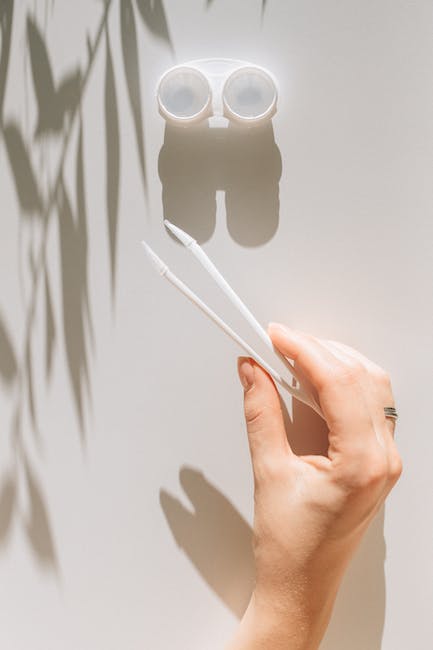Who Cannot Wear Contact Lenses

Contact lenses are a popular and convenient way to correct vision. However, not everyone is suitable or safe to wear contact lenses. There are certain people who should not wear contact lenses, such as those with certain medical conditions, those with an allergy to the materials used in contact lenses, and those who have had an eye injury or surgery. People with dry eyes may also find it difficult to comfortably wear contact lenses.Certain individuals cannot wear contact lenses due to medical or lifestyle reasons. These include people with certain eye diseases such as conjunctivitis, dry eye, keratoconus, corneal ulcers, and corneal dystrophy. People with allergies to contact lens materials or solutions should also avoid contact lenses. In addition, people who work in dusty or smoky environments and those who take part in contact sports should not wear contact lenses either.
Types of Eye Conditions That Prevent Wearing of Contact Lenses
Eye conditions can prevent the successful use of contact lenses, or make them uncomfortable to wear. Some of the most common eye conditions that can cause this are dry eyes, allergies, conjunctivitis, blepharitis, corneal ulcers and astigmatism. Dry eyes are a very common complaint among contact lens wearers, and can be caused by a variety of factors including medications and environmental conditions. Allergies can also cause irritation when wearing contact lenses, often due to an allergic reaction to the materials used to make them. Conjunctivitis is an inflammation of the eye that can cause irritation and sensitivity to light when wearing contact lenses. Blepharitis is an inflammation of the eyelids that can cause discomfort when wearing contact lenses due to irritation and inflammation. Corneal ulcers occur when bacteria or fungi enter the eye through a scratch or other injury; these need to be treated with antibiotics before contact lenses can be worn safely again. Finally, astigmatism is an irregular curvature of the cornea which causes blurred vision at all distances; this condition requires specific types of contacts in order to correct vision properly.
In some cases, wearing contact lenses can actually worsen certain eye conditions. People with severe dry eyes should not wear contacts as they will worsen symptoms such as redness, burning and itching. People with active allergies should also avoid wearing contacts until their symptoms have resolved as they may further irritate already inflamed eyes. In addition, people with active infections such as conjunctivitis should not wear contacts until their condition has been treated because it could spread bacteria or fungi onto the contacts which could then infect other people who use them.
It is important for anyone considering wearing contact lenses to have a comprehensive eye exam first so that any existing eye conditions can be identified and managed appropriately before attempting to wear contacts. This will ensure that any potential risks associated with contact lens wear are minimized and avoided altogether if necessary.
Living With Dry Eyes
Dry eyes are an uncomfortable and debilitating condition that affects millions of people worldwide. It can cause a variety of symptoms, including redness, burning, stinging, itching, blurred vision and even eye discharge. Fortunately, there are ways to manage dry eyes and reduce the severity of the symptoms. Here are some tips for living with dry eyes:
Stay Hydrated
It’s important to stay hydrated when you have dry eyes. Drink plenty of water throughout the day to keep your body properly hydrated. This will help reduce the symptoms of dry eyes and make them more manageable.
Wear Sunglasses
When you’re outdoors, it’s important to wear sunglasses that block out UV rays. This will help protect your eyes from the sun’s harsh rays and reduce irritation caused by wind or other elements. Additionally, wearing sunglasses can help reduce glare from bright surfaces like snow or sand.
Avoid Smoke
Smoke can irritate your eyes and make your dry eye symptoms worse. If you smoke, quit as soon as possible. If you live with someone who smokes, ask them to smoke outside or in another room to reduce their exposure to smoke and improve your own comfort level.
Use Humidifiers
Humidifiers can be beneficial for people with dry eyes because they add moisture into the air which helps keep your eyes lubricated and comfortable. If you don’t already have a humidifier in your home or office, consider investing in one as it could really help improve your comfort level.
Use Artificial Tears
Artificial tears are available over-the-counter in many drug stores and pharmacies. They are designed to lubricate your eyes and provide relief from discomfort caused by dryness. Use artificial tears several times a day as needed for symptom relief.
See Your Doctor
If home remedies don’t seem to be helping with your dry eye symptoms, make an appointment with an optometrist or ophthalmologist for further evaluation and treatment options tailored to your needs.
Advice for People With Active Eye Infections
Eye infections can be painful and uncomfortable, and it is important to take the necessary steps to treat them as quickly and effectively as possible. People with active eye infections should contact their doctor or optometrist immediately. They should also follow their doctor’s advice for the best results. Avoiding activities that could cause further irritation or damage to the eye is essential. This includes avoiding swimming, contact sports, or any activity that could cause trauma to the infected eye.
Applying warm compresses may help relieve discomfort associated with an eye infection. It is important to use clean materials when applying compresses, such as a clean washcloth or paper towel that has been soaked in warm water and wrung out thoroughly. To avoid contamination, do not reuse materials after they have been used once.
When treating an infection with oral medication, it is important to take antibiotics as directed by a doctor and finish the entire course of treatment. Doing so helps ensure that all of the bacteria causing the infection are destroyed before symptoms subside. If medications are not taken according to instructions, the infection may recur or become more difficult to treat in the future.
In addition to taking medication as prescribed by a doctor, people with active eye infections should also take steps at home to keep their eyes healthy and reduce their risk of recurrent infections. This includes avoiding touching or rubbing their eyes, using clean tissues when wiping away tears or discharge from their eyes, washing hands frequently, and taking steps to reduce stress levels which can weaken immunity and increase susceptibility to infection.
Living with Corneal Disease
Corneal disease is a condition in which the cornea of the eye becomes damaged or diseased, resulting in vision problems. People with corneal disease can experience a variety of symptoms, including blurred vision, decreased night vision, sensitivity to light, and pain. The condition can also lead to scarring of the cornea and even blindness. Treatment for corneal disease depends on the type and severity of the condition, but may include medication, surgery, or lifestyle changes.
For those living with corneal disease, it’s important to take extra precautions to protect your eyesight. Wear sunglasses when outdoors and avoid bright lights that can cause discomfort or further damage. If you wear contact lenses, switch to glasses as often as possible to give your eyes a break from the lenses. Additionally, eat a healthy diet that includes foods rich in vitamins A and C for eye health.
It’s also important to monitor your eye health regularly by having regular check-ups with an ophthalmologist or optometrist. Early detection and treatment of any changes in your vision is essential for preserving as much vision as possible with corneal disease. If you experience any changes in your vision or discomfort in your eyes, talk to your doctor immediately about what steps you should take.
Living with a chronic eye condition like corneal disease can be difficult, but there are resources available for those living with this condition. Support groups and counseling services are available for those who need help managing their symptoms or adjusting to life after diagnosis. Additionally, many organizations provide information on financial assistance for those who need help paying for their treatments and medications associated with their corneal disease diagnosis.

Living With Keratoconus
Keratoconus is a progressive eye condition that affects the cornea, the clear window on the front of the eye. It causes the cornea to thin and bulge outward, resulting in blurry vision and sensitivity to light. People with keratoconus often need glasses or contact lenses to help them see clearly. They may also require surgery to correct their vision. Living with keratoconus can be a challenge, but there are ways to make it easier. Here are some tips for managing keratoconus:
See an Eye Care Professional Regularly
It’s important for people with keratoconus to get regular eye exams from an optometrist or ophthalmologist. This will help your doctor monitor your vision and adjust your eyeglasses or contact lenses as needed. Your doctor may also be able to recommend treatments such as eye drops, special glasses, or even surgery if necessary.
Wear Protective Eyewear
People with keratoconus should avoid activities that could put their eyes at risk such as playing sports without proper protective eyewear. Wearing sunglasses when outdoors can also help reduce glare and protect your eyes from UV rays.
Use Artificial Tears
Dry eyes can be a common symptom of keratoconus, so it’s important for people with the condition to keep their eyes lubricated by using artificial tears regularly. These can be purchased over-the-counter at most pharmacies.
Manage Stress Levels
Stress has been linked to worsening symptoms of keratoconus, so it’s important for people with the condition to find ways to manage stress levels. This could include things like yoga, meditation, or simply taking time out of each day for relaxation.
By following these tips and staying in close contact with your eye care professional, you can better manage your keratoconus and keep it from getting worse.
Uneven Corneas in Patients
Uneven corneas can be a concern for many patients, especially those who wear contact lenses. When the cornea has an uneven shape, vision can be impaired and contact lenses may not fit properly. Uneven corneas can be caused by many factors, including genetics, age, and disease or injury. Treatment for uneven corneas depends on the cause and severity of the condition.
In some cases, the unevenness of the cornea may not cause any symptoms and may not require treatment. If symptoms are present or if vision is affected, a doctor may recommend corrective lenses or surgery to reshape the cornea. Corrective lenses such as glasses or contact lenses can help to improve vision and provide a better fit for contacts if needed. In more severe cases, surgery may be required to reshape the cornea and improve vision.
When considering treatment options for uneven corneas, it is important to discuss all of the risks and benefits with your doctor. Surgery carries certain risks such as infection, scarring, dry eye syndrome, and other complications that need to be considered before making a decision. It is also important to consider whether the benefits will outweigh any potential risks associated with surgery before deciding on treatment.
For patients with uneven corneas who do not require corrective lenses or surgery, there are certain measures that can help protect their eyes from further damage. Wearing sunglasses when outdoors can help protect against UV rays which can damage the eyes over time. Additionally, using preservative-free eye drops regularly may help keep eyes hydrated and reduce symptoms of dryness or discomfort associated with unevenness in the cornea.
Uneven corneas can affect vision and cause discomfort in some patients but with proper management and treatment options available it does not have to be a long-term problem. Discussing all available options with your doctor is essential when considering treatment for an irregularly shaped cornea so you can make an informed decision about what is best for you.
Treating Those With Immature Corneas
Corneal immaturity is a condition that affects the front of the eye, making it difficult for a person to see clearly. In some cases, the cornea may be too thin or have an irregular shape, which can lead to vision problems. Treatment for this condition can involve medications, glasses, contact lenses, and even surgery.
When it comes to treating those with immature corneas, there are many options available. The most common approach is the use of corrective lenses. These lenses can help to improve vision by changing the way light enters the eye and correcting any refractive errors. Contact lenses are also a popular treatment option as they provide better vision than glasses and can be more comfortable than rigid gas permeable (RGP) lenses.
In more severe cases, surgery may be necessary to improve vision and reduce symptoms associated with corneal immaturity. Refractive surgeries such as LASIK or PRK involve reshaping the cornea in order to correct refractive errors. Other surgical techniques such as intrastromal corneal ring segments (ICRS) or phakic intraocular lens implantation (PIOL) can also help to correct vision problems associated with corneal immaturity.
Finally, medications may be prescribed by an ophthalmologist if there is an underlying condition causing the cornea’s immaturity. Anti-inflammatory drugs and steroids may be used to reduce inflammation in the eye and improve vision. Additionally, topical medications such as artificial tears or lubricants may be used to relieve dryness and irritation associated with immature corneas.
In summary, treatment for those with immature corneas varies depending on the severity of their condition and underlying cause. Corrective lenses are often used for mild cases while more complex treatments such as surgery or medications may be required for more severe cases. It is important for those affected by this condition to discuss their options with their ophthalmologist in order to determine which treatment plan will best suit their needs.

Conclusion
Contact lenses are a great alternative to glasses for certain individuals. However, it is important to note that not everyone can wear contact lenses. People who suffer from certain medical conditions such as Dry Eye Syndrome, Keratoconus, or those with allergies may not be able to wear contact lenses. People who have a history of eye infections should also avoid wearing contact lenses. Children, especially those younger than eight years old, should also not wear contact lenses due to their still-developing eyes.
It is important to consult with an eye care professional before wearing contact lenses in order to ensure proper safety and health standards are met. This can also help in determining which type of lens would be best suited for any individual’s particular needs and lifestyle.
By understanding the risks associated with wearing contact lenses and taking the necessary precautions, people can safely enjoy the convenience and comfort that come with wearing contacts.
